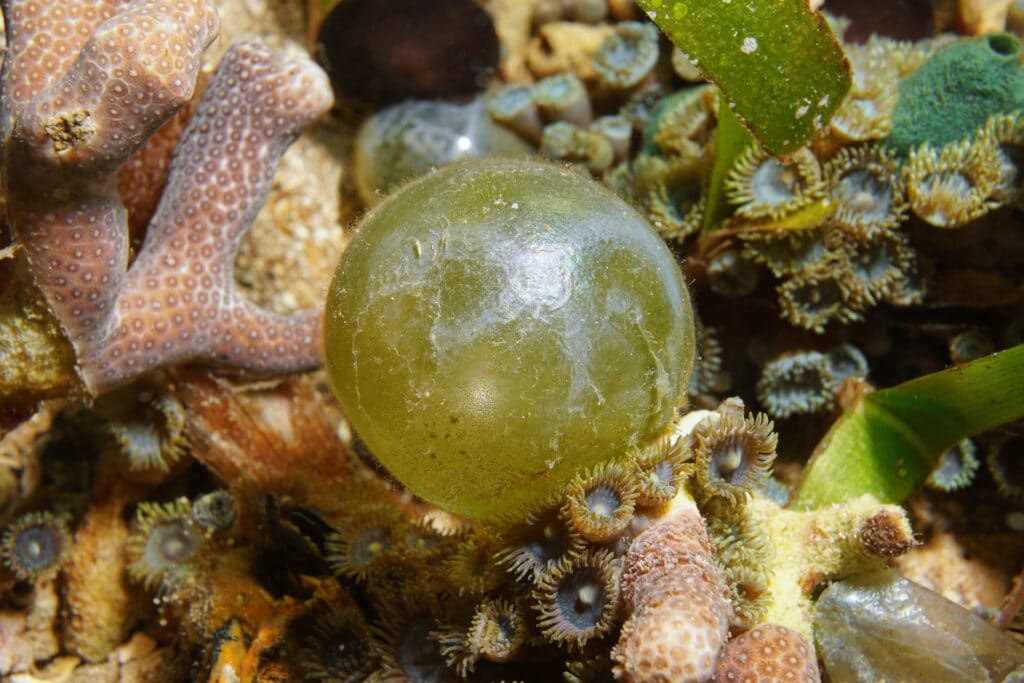Chalice Coral: A Comprehensive Guide for Beginners
Corals are not just beautiful creatures that add color to an underwater world, but they also play a vital role...
Jim Sabellico
January 21, 2022

If you’re truly a reef tank addict then chances are pretty strong that at one point or another during your reefing journey you’re going to come face to face with bubble algae.
In this article, we’ll aim to cover some important information on what bubble algae is, its effects in your reef tank, and how to prevent and remove it from your tank. So let’s start from the very beginning, what is bubble algae?
Bubble algae (Valonia ventricosa) are a specie of algae found all over the world on most reefs (ridges or shoals of rocks, corals or similar relatively stable materials, lying beneath the surface of a natural body of water). Bubble algae, also known as sailor’s eyeballs, typically grow individually, but in rare cases they can grow in groups.
If you own an aquarium or love the aquatic life, you might have seen them before and wondered what those shiny green balls were—although in water they may appear to be silver, teal, or even blackish. Bubble alga (singular) is one of the largest known single-celled organisms in the world. It’s almost unbelievable that some of those huge green balls are a single cell. When it spreads in a reef tank, it can overhaul corals, block pipes, and cause overflows. Some fish and crabs eat bubble algae, which can easily rupture the algae and make them difficult to remove from a tank. Examples of aquatic herbivores that feed on bubble algae are Rabbitfish, Yellow Tangs, and Emerald Crabs.
When growing densely, bubble algae can appear as a large number of usually small, bubble-like structures. However, while technically microalgae, they can resemble macroalgae in size; some individual specimens under study have reportedly reached the size of a tennis ball. How do they get so big with chances of reproducing so quickly? Reproduction in bubble algae occurs by segregative cell division, where the multinucleate parent cell makes child cells, and individual rhizoids form new bubbles, which become separate from the parent cell. (Wikipedia.org). Thus, bursting them can hardly be considered a reasonable method of control because it releases hundreds or even thousands of new cells into the water column—an algae outbreak! Knowing the extent of damage that these “unwanted invaders” can cause you in terms of money, time, and effort, it becomes pretty much necessary to know how to control them.
Several methods to get rid of bubble algae have been tested by many people, however, the results are usually not the same with everyone—some were successful and others not so lucky. Your best shot is to manually remove the first bubble immediately after you identify it without popping it. You can use a sharp flat chisel to work around the base of the bubble to uproot it. This may require some caution, but it will surely save you the pain of having your tank invaded by bubble algae eventually if you did nothing.
While removing the bubbles, they can easily float away and spread somewhere else; hence, ensure that you have a siphon to suck up the bubbles. You can clamp a filter sock inside a sump and run a siphon from the display into the sock. This approach helps to retain the water in the system and catches all the bubbles for easy removal.
Bubble algae are food for some creatures, as mentioned earlier, Rabbitfish, Yellow Tangs, and Emerald Crabs among others are widely known for eating these algae. Different people have different opinions about this though; some people believe that these creatures rarely eat the bubble algae. This may depend on the type of animal and other feeding conditions in your tank. It should not be strange if animals sometimes lose their appetite too. I will advise that you don’t rely too much on the creatures to keep your tank algae-free so that you will not be disappointed. Yes they can help, but they shouldn’t be your only plan for keeping bubble algae out of your tank. What other options are available?
The best way to prevent a breakout of any organism and even to get rid of an existing one is to remove its food source—and this applies to bubble algae. If your tank is running at near-zero nitrates algae will find it very difficult to grow. This is why it is important to regularly change your filter media (e.g., your socks) and have a protein skimmer. This will prevent any algae from feeding on certain organics that decompose into nitrates. You can be sure that once the bubble algae have nothing to eat, their days are numbered and will eventually vanish from your tank.
When fish poop, nitrates are introduced into your tank. One approach to reducing the number of nitrates is by reducing their feeding. Furthermore, you may also want to reduce mechanical filtration when removing organics. A better alternative to pulling the excess nutrients out of your tank is actually by growing beneficial algae.
For example, algae like chaetomorpha can be grown using a refugium (an appendage to a marine, brackish, or freshwater fish tank that shares the same water supply). This technique encourages these algae to grow in an unseen location in your stand and not in your display tank. You simply let it grow and cut back the growth and regularly removing the cuttings from the tank. This helps ensure you are actually taking out the nutrients that feed the algae not just transferring it from one form to another.
Conclusion
Finally, prevention, they say, is better than cure. Inspect your new live rock and coral frags for any hitchhikers you can remove. It is always best to quarantine them to be safe. The keeps unwanted organisms out at the early stages.
Once introduced into your tank the best way to prevent a bubble algae outbreak is to deprive them of food. You can keep the nitrate levels low with good filtration and nutrient removal systems. If you are faced with a growing bubble algae problem, do your best to remove the bubbles without rupturing them as this releases the spores into the tank for more to likely grow.

I am the founder of J. Louis, a digital marketing agency focused on providing innovative solutions and strategies built on a foundation of creative design and technology. A family man who loves travel and reef tanks, I’ve been coined as a jack of all trades, master of a few of them, most specifically website and sales funnel design, monetization and growth strategies, and viral marketing. I began pursuing my passions for business by cutting my neighbor’s lawns when I was just 8 years old and never looked back. Over the past 20 years, I have amassed significant experience providing consulting, design and development services for Fortune 500 companies, government, retail, private individuals, and A-list celebrities.
Corals are not just beautiful creatures that add color to an underwater world, but they also play a vital role...
As we move into the new year, it's time to start thinking about what reef tank LED lighting kits will...

Proceeds from all purchases go directly to Great Barrier Reef Foundation and supporting their mission.
Want to stay connected with all the latest news in the Reef Tank Addict community? Drop your email below!
Proudly Supporting The Great Barrier Reef Foundation
